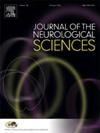Detailed immune cell profiling of paediatric patient with limb girdle muscular dystrophy R3
IF 3.2
3区 医学
Q1 CLINICAL NEUROLOGY
引用次数: 0
Abstract
Muscular dystrophies are associated with inflammation and necrotic myofibres where muscle is replaced with adipocytes/fibrosis. Glucocorticoids provide clinical improvement in reducing immune markers for some muscular dystrophies however, knowledge of the immune cells involved is limited. Here we present a childhood onset case of Limb Girdle Muscular Dystrophy (LGMD) with two pathogenic variants for SGCA gene. Muscle biopsy (eight-years) was consistent with sarcoglycanopathy, revealing necrotic myofibres, inflammatory infiltrate (CD45+) positive for monocyte/macrophages (CD45+CD68+) and evidence of adipocytes/fibrosis. Blood was collected (eleven-years) to perform detailed immune cell profiling identifying >60 subtypes of Innate, T and B cells (compared to age-sex matched controls). We found alterations in natural killer (NK) cells (CD3−CD19−CD20−CD14-CD56dim/bright), monocytes (CD3−CD19−CD20−CD14+/-HLADR+CD16+/−), dendritic cells (DCs) (CD3−CD19−CD20−CD14−CD16−HLADR+), T lymphocytes (CD3+CD4+/-CD8+/−), unconventional T lymphocytes (CD3+γδTCR+ and CD3+Vα7.2hiCD161hi and CD3+TCRVα24Jα18) and B lymphocytes (CD3−CD19+CD20+). This is the first study to perform detailed immune cell profiling of a LGMD patient. The data presented is a singular result but highlights the need to build cohort studies for a more in-depth investigation of the LGMDR3 immune profile and discovery of immune targeted therapies.
小儿肢带性肌营养不良R3患者的详细免疫细胞谱分析
肌肉萎缩症与炎症和坏死肌纤维有关,其中肌肉被脂肪细胞/纤维化所取代。糖皮质激素在减少某些肌肉萎缩症的免疫标记物方面提供临床改善,然而,对涉及的免疫细胞的了解有限。在这里,我们提出一个儿童发病的肢体带状肌营养不良症(LGMD)与两个致病变异的SGCA基因。肌肉活检(8年)与肌糖病变一致,显示坏死肌纤维,单核细胞/巨噬细胞(CD45+CD68+)炎症浸润(CD45+)阳性,脂肪细胞/纤维化的证据。收集血液(11年)进行详细的免疫细胞谱分析,确定60种先天性、T细胞和B细胞亚型(与年龄性别匹配的对照组相比)。我们发现自然杀伤细胞(NK) (CD3 - CD19 - CD20 - CD14- cd56dim /bright)、单核细胞(CD3 - CD19 - CD20 - CD14+/-HLADR+CD16+/ -)、树突状细胞(dc) (CD3 - CD19 - CD20 - CD14- CD16 -HLADR+)、T淋巴细胞(CD3+CD4+/-CD8+/ -)、非常规T淋巴细胞(CD3+γδTCR+和CD3+Vα7.2hiCD161hi和CD3+ tcrv α 24j - α18)和B淋巴细胞(CD3 - CD19+CD20+)发生了变化。这是第一个对LGMD患者进行详细免疫细胞分析的研究。提出的数据是一个单一的结果,但强调需要建立队列研究,以更深入地研究LGMDR3免疫谱和发现免疫靶向治疗。
本文章由计算机程序翻译,如有差异,请以英文原文为准。
求助全文
约1分钟内获得全文
求助全文
来源期刊

Journal of the Neurological Sciences
医学-临床神经学
CiteScore
7.60
自引率
2.30%
发文量
313
审稿时长
22 days
期刊介绍:
The Journal of the Neurological Sciences provides a medium for the prompt publication of original articles in neurology and neuroscience from around the world. JNS places special emphasis on articles that: 1) provide guidance to clinicians around the world (Best Practices, Global Neurology); 2) report cutting-edge science related to neurology (Basic and Translational Sciences); 3) educate readers about relevant and practical clinical outcomes in neurology (Outcomes Research); and 4) summarize or editorialize the current state of the literature (Reviews, Commentaries, and Editorials).
JNS accepts most types of manuscripts for consideration including original research papers, short communications, reviews, book reviews, letters to the Editor, opinions and editorials. Topics considered will be from neurology-related fields that are of interest to practicing physicians around the world. Examples include neuromuscular diseases, demyelination, atrophies, dementia, neoplasms, infections, epilepsies, disturbances of consciousness, stroke and cerebral circulation, growth and development, plasticity and intermediary metabolism.
 求助内容:
求助内容: 应助结果提醒方式:
应助结果提醒方式:


